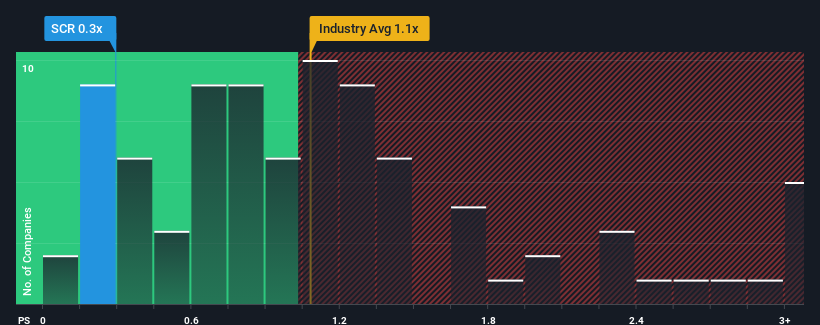Cautious Investors Not Rewarding SCOR SE's (EPA:SCR) Performance Completely
When close to half the companies operating in the Insurance industry in France have price-to-sales ratios (or "P/S") above 1.1x, you may consider SCOR SE (EPA:SCR) as an attractive investment with its 0.3x P/S ratio. Nonetheless, we'd need to dig a little deeper to determine if there is a rational basis for the reduced P/S.
Check out our latest analysis for SCOR

What Does SCOR's Recent Performance Look Like?
With revenue growth that's inferior to most other companies of late, SCOR has been relatively sluggish. It seems that many are expecting the uninspiring revenue performance to persist, which has repressed the growth of the P/S ratio. If you still like the company, you'd be hoping revenue doesn't get any worse and that you could pick up some stock while it's out of favour.
Keen to find out how analysts think SCOR's future stacks up against the industry? In that case, our free report is a great place to start.How Is SCOR's Revenue Growth Trending?
There's an inherent assumption that a company should underperform the industry for P/S ratios like SCOR's to be considered reasonable.
Taking a look back first, we see that there was hardly any revenue growth to speak of for the company over the past year. This isn't what shareholders were looking for as it means they've been left with a 6.9% decline in revenue over the last three years in total. Accordingly, shareholders would have felt downbeat about the medium-term rates of revenue growth.
Turning to the outlook, the next three years should generate growth of 9.9% each year as estimated by the nine analysts watching the company. Meanwhile, the rest of the industry is forecast to expand by 10% per year, which is not materially different.
With this information, we find it odd that SCOR is trading at a P/S lower than the industry. It may be that most investors are not convinced the company can achieve future growth expectations.
What Does SCOR's P/S Mean For Investors?
Using the price-to-sales ratio alone to determine if you should sell your stock isn't sensible, however it can be a practical guide to the company's future prospects.
We've seen that SCOR currently trades on a lower than expected P/S since its forecast growth is in line with the wider industry. Despite average revenue growth estimates, there could be some unobserved threats keeping the P/S low. It appears some are indeed anticipating revenue instability, because these conditions should normally provide more support to the share price.
It is also worth noting that we have found 2 warning signs for SCOR that you need to take into consideration.
If companies with solid past earnings growth is up your alley, you may wish to see this free collection of other companies with strong earnings growth and low P/E ratios.
New: Manage All Your Stock Portfolios in One Place
We've created the ultimate portfolio companion for stock investors, and it's free.
• Connect an unlimited number of Portfolios and see your total in one currency
• Be alerted to new Warning Signs or Risks via email or mobile
• Track the Fair Value of your stocks
Have feedback on this article? Concerned about the content? Get in touch with us directly. Alternatively, email editorial-team (at) simplywallst.com.
This article by Simply Wall St is general in nature. We provide commentary based on historical data and analyst forecasts only using an unbiased methodology and our articles are not intended to be financial advice. It does not constitute a recommendation to buy or sell any stock, and does not take account of your objectives, or your financial situation. We aim to bring you long-term focused analysis driven by fundamental data. Note that our analysis may not factor in the latest price-sensitive company announcements or qualitative material. Simply Wall St has no position in any stocks mentioned.
About ENXTPA:SCR
SCOR
Provides life and non-life reinsurance products in Europe, the Middle East, Africa, the Americas, Latin America, and the Asia Pacific.
Undervalued established dividend payer.
Similar Companies
Market Insights
Community Narratives



